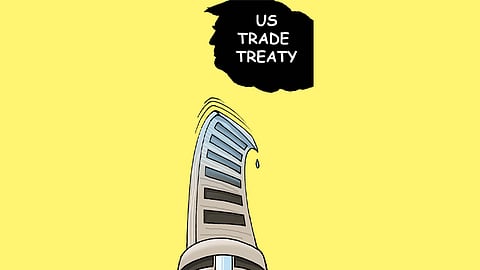Fear not, fret not
Stock markets hate uncertainty. Ahead of 1 August, the deadline set for India to ink the US trade treaty – mini or otherwise – investors are spooked as to whether it will happen or not. While the treaty with the UK was seen as a rehearsal, it is the US trade treaty which will be the decider. While investors are not exactly gnawing their nails, they prefer to see an outcome and hence are reluctant to expand their investments, preferring instead to remain in cash. The BSE Sensex, mirroring this sentiment, has seen a sharp erosion. From a level of just under 83,700 on 1 July, the index has lost considerable ground.
There are two possibilities if negotiations do not yield a definitive result by 1 August. The US government may allow further time on the grounds that the agreement is in its final stages and will be concluded in a few days. The other possibility is that the US government may impose additional tariffs in the interim, ranging between 15-50 per cent, as President Trump has threatened.
While the heavens will most certainly not fall if the agreement is not inked by 1 August, investors could still be slightly dented. But it is not as if the markets will become significantly more unnerved in such a scenario. Markets generally tend to react more ahead of the event, and the actual event may not trigger further volatility. As in the case of a company’s results, when traders expect good results and the results are indeed good, the market may still decline on profit-taking by traders who had bought in anticipation. Likewise, in the case of the US treaty, markets are slowly factoring in the worst. This is being reflected in share prices. While there is a view that markets will tolerate tariff increases within the 10-20 per cent range, the actual outcome of the treaty – whether it is signed or not – may not provoke a sharper negative reaction.
Investors are also aware that the US, despite flexing its muscles, cannot really afford to impose high punitive tariffs on various countries from which it imports goods. The rationale is that higher tariffs are invariably passed on to the end consumers, thereby pushing up prices and unleashing inflationary pressures in the economy. As it stands, inflation in the US for June is expected to be around three per cent, which is on the higher side. The deficit has also increased, with higher import duties being cited as one of the factors contributing to a larger import bill. In May, the trade deficit on goods and services was $71.5 billion, higher than the $60.3 billion recorded in April.
The extent to which actual tariffs will push up prices also depends on how soon the US can finalise trade agreements with other countries. If not, it may dent US consumers’ pockets, resulting in a rise in living costs and, ultimately, a general increase in prices. Higher prices could also lead to reduced consumer spending, which in turn could translate into higher interest payments. The US dollar is already weakening against major developed currencies, and higher inflation may further erode its value.
While these remain possible scenarios going forward, it is already well known that several central banks in various countries have been shoring up gold reserves instead of investing in USD or US government treasury bills and securities.
It is not just the Indian markets that are concerned about this uncertainty, but also other countries that must finalise trade deals by 1 August. The weakening dollar is itself a reflection of unsettled currency markets.
Beyond inking the trade deals, it is also important to consider the quality of those deals. For India, this is even more significant. As it has declared on various fora, opening up Indian markets to agricultural products – including genetically modified seeds and produce – is non-negotiable. India had maintained this position in the preliminary announcement regarding the UK treaty, and it is unlikely to make an exception for the US.
Globally, markets – whether stock, commodity, or foreign exchange – will heave a sigh of relief once the US signs trade agreements with various countries before 1 August. One remains optimistic that India will be able to sign a mini agreement with the US. Markets do not really need to fear even if the agreement is not signed or if the deadline is extended. Ultimately, while sentiments are impacted ahead of such events, markets must recognise that domestic performance is more dependent on expectations around corporate results and how companies will perform in the coming months. And no brownie points for guessing: with India steadfastly on a growth path, India Inc will continue to do well.

